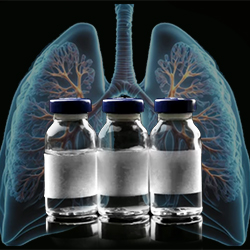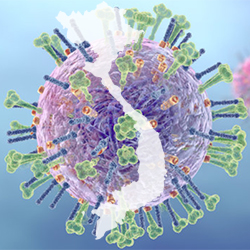By Leah Lawrence
The best tools to prepare for the coming respiratory season are education and vaccination, according to Manisha Patel, MD, MS, MBA, the chief medical officer for the CDC’s National Center for Immunization and Respiratory Diseases and a captain in the U.S. Public Health Service.

Last year, the United States faced the “tripledemic,” with a surge in infections from influenza, COVID-19 and respiratory syncytial virus (RSV) that stretched healthcare resources, he said.
So, what will this season bring?
Predicting the exact behavior of winter respiratory viruses is a hazardous profession, admitted William Schaffner, MD, a professor of preventive medicine at Vanderbilt University School of Medicine, in Nashville, Tenn.
“We are often wrong,” Dr. Schaffner said. “We can predict with assurance though that there will be flu, there will be COVID-19 and there will be RSV. How much and when the annual increases will start is a wait-and-see proposition.”
Influenza
The Southern Hemisphere’s respiratory illness season starts earlier in the year than the Northern Hemisphere’s season, but does not necessarily predict what the United States, they said. In the year to date in Australia, there were 202,428 notifications of laboratory-confirmed influenza reported to the National Notifiable Diseases Surveillance System.
“This is 7.5% lower than the number of notifications over the same period in 2022, but 75% higher than the five-year average over the years 2016-19 and 2022,” according to a spokesperson from the Australian Government Department of Health and Aged Care.
Australia also experienced its fifth COVID-19 omicron wave over its winter season, which was driven by existing and newly emerging recombinant omicron subvariants.
Regardless of what happens in the Southern Hemisphere, it is important for the United States to be prepared, Dr. Patel said. And vaccines are the best tools to protect patients against severe illness, the experts said.
So far, it looks like this influenza season’s vaccine, which is recommended for all people aged 6 months or older with contraindications (MMWR Recomm Rep 2023;72[RR-2]:1-25), is a good match against circulating strains, according to Dr. Schaffner.
However, the vaccine is only effective when used—one-third of those 65 and older do not receive an annual flu shot. “We need to do better with the flu vaccine than we have in the past,” Dr. Schaffner said.
September or October are the best months to receive the flu vaccine, according to Dr. Patel, however, even if someone cannot be vaccinated until December or later, vaccination is still recommended because flu activity can continue into May.
COVID-19
Recently, the CDC announced it has detected a new SARS-CoV-2 variant labeled BA.2.86 that has multiple genetic differences from previous versions of SARS-CoV-2. The agency said this variant “may be more capable of causing infection in people who have previously had COVID-19 or who have received COVID-19 vaccines, and is studying its potential impact on public health.”
The current CDC COVID-19 vaccine recommendations advise that all people who are 6 years of age and older get one updated Pfizer-BioNTech or Moderna COVID-19 vaccine, regardless of whether they’ve received any original COVID-19 vaccines. People who are 65 and older may get one additional dose of COVID-19 vaccine four or more months after the first updated vaccine, and those who are moderately or severely immunocompromised may get one additional dose of updated COVID-19 vaccine two or more months after the last updated COVID-19 vaccine.
An updated vaccine should be available soon. The FDA’s Vaccines and Related Biological Products Advisory Committee met in June and unanimously voted that the 2023-2024 COVID-19 vaccine composition be updated to a monovalent COVID-19 vaccine with an XBB lineage of the omicron variant, expressing a preference for XBB.1.5.
However, If clinicians have a patient who is interested in getting the COVID-19 vaccine, especially a patient who is at high risk for severe disease or has never been vaccinated, they should offer the currently available vaccine while they have them in the clinic, Dr. Patel said.
RSV
In May, the FDA approved two RSV vaccines in the United States, Arexvy (GSK) and Abrysvo (Pfizer), to prevent lower respiratory tract disease (LRTD) caused by RSV in individuals who are 60 or older. The CDC has recommended that older adults receive a single dose of RSV vaccine using shared clinical decision making, Dr. Patel said.
Influenza, RSV and COVID-19 vaccines can be given at the same appointment. Some patients may prefer to spread out these vaccines because getting all three together can be more reactogenic, but there’s nothing prohibiting patients from getting all three together if they choose to do so, according to Dr. Patel.
Dr. Schaffner noted that although the CDC said all three vaccines—influenza, COVID-19 and RSV—can be given at the same time, it also acknowledged that data supporting simultaneous administration for RSV with other vaccines are still pretty modest.
“I believe that a lot of physicians who will recommend giving the RSV vaccine will do it separately from COVID and flu,” Dr. Schaffner said.
What About Children?
Children have not been forgotten. Over the summer, the FDA extended Abrysvo’s indications to include use in pregnant individuals to prevent LRTD and severe LRTD caused by RSV in infants from birth through 6 months of age. In July, the FDA approved the passive immunization, nirsevimab-alip (Beyfortus, Sanofi), which is recommended for neonates and infants born during or entering their first RSV season, and in children 8 to 19 months who remain vulnerable to severe RSV disease through their second RSV season.
Nirsevimab is a monoclonal antibody with activity against RSV; it is administered as a single intramuscular injection.
Without a crystal ball, there is no way to predict with any certainty what the coming respiratory virus season will bring, but Dr. Schaffner said you can be sure that all of these viruses will be active.
Drs. Patel and Schaffner reported no relevant financial disclosures.




